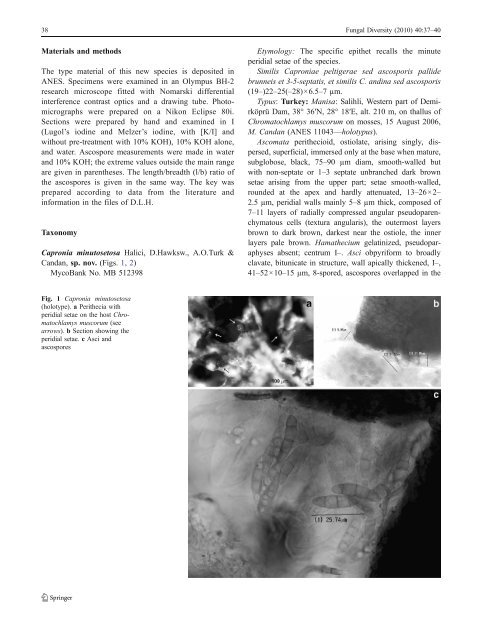A new lichenicolous species of Capronia (Ascomycota ...
A new lichenicolous species of Capronia (Ascomycota ...
A new lichenicolous species of Capronia (Ascomycota ...
Create successful ePaper yourself
Turn your PDF publications into a flip-book with our unique Google optimized e-Paper software.
38 Fungal Diversity (2010) 40:37–40<br />
Materials and methods<br />
The type material <strong>of</strong> this <strong>new</strong> <strong>species</strong> is deposited in<br />
ANES. Specimens were examined in an Olympus BH-2<br />
research microscope fitted with Nomarski differential<br />
interference contrast optics and a drawing tube. Photomicrographs<br />
were prepared on a Nikon Eclipse 80i.<br />
Sections were prepared by hand and examined in I<br />
(Lugol’s iodine and Melzer’s iodine, with [K/I] and<br />
without pre-treatment with 10% KOH), 10% KOH alone,<br />
and water. Ascospore measurements were made in water<br />
and 10% KOH; the extreme values outside the main range<br />
are given in parentheses. The length/breadth (l/b) ratio <strong>of</strong><br />
the ascospores is given in the same way. The key was<br />
prepared according to data from the literature and<br />
information in the files <strong>of</strong> D.L.H.<br />
Taxonomy<br />
<strong>Capronia</strong> minutosetosa Halici, D.Hawksw., A.O.Turk &<br />
Candan, sp. nov. (Figs. 1, 2)<br />
MycoBank No. MB 512398<br />
Fig. 1 <strong>Capronia</strong> minutosetosa<br />
(holotype). a Perithecia with<br />
peridial setae on the host Chromatochlamys<br />
muscorum (see<br />
arrows). b Section showing the<br />
peridial setae. c Asci and<br />
ascospores<br />
Etymology: The specific epithet recalls the minute<br />
peridial setae <strong>of</strong> the <strong>species</strong>.<br />
Similis <strong>Capronia</strong>e peltigerae sed ascosporis pallide<br />
brunneis et 3-5-septatis, et similis C. andina sed ascosporis<br />
(19–)22–25(–28)×6.5–7 µm.<br />
Typus: Turkey: Manisa: Salihli, Western part <strong>of</strong> Demirköprü<br />
Dam, 38° 36′N, 28° 18′E, alt. 210 m, on thallus <strong>of</strong><br />
Chromatochlamys muscorum on mosses, 15 August 2006,<br />
M. Candan (ANES 11043—holotypus).<br />
Ascomata perithecioid, ostiolate, arising singly, dispersed,<br />
superficial, immersed only at the base when mature,<br />
subglobose, black, 75–90 µm diam, smooth-walled but<br />
with non-septate or 1–3 septate unbranched dark brown<br />
setae arising from the upper part; setae smooth-walled,<br />
rounded at the apex and hardly attenuated, 13–26×2–<br />
2.5 µm, peridial walls mainly 5–8 µm thick, composed <strong>of</strong><br />
7–11 layers <strong>of</strong> radially compressed angular pseudoparenchymatous<br />
cells (textura angularis), the outermost layers<br />
brown to dark brown, darkest near the ostiole, the inner<br />
layers pale brown. Hamathecium gelatinized, pseudoparaphyses<br />
absent; centrum I–. Asci obpyriform to broadly<br />
clavate, bitunicate in structure, wall apically thickened, I–,<br />
41–52×10–15 µm, 8-spored, ascospores overlapped in the

















